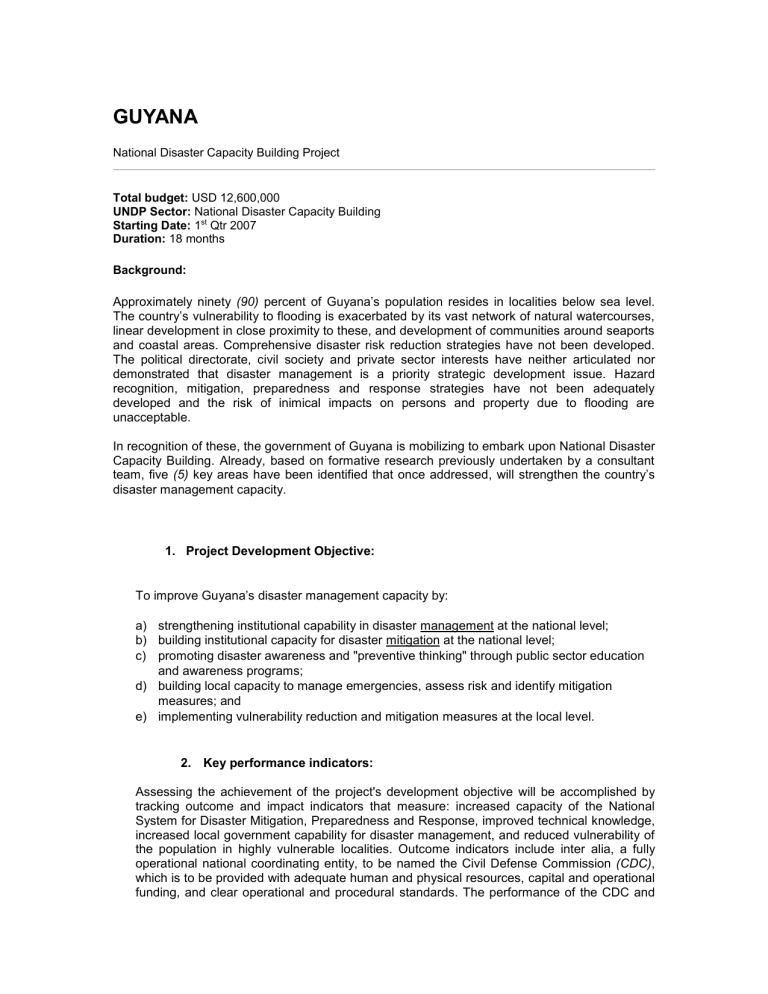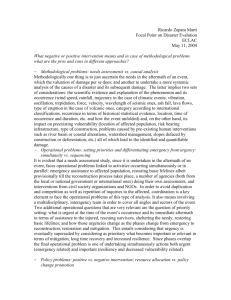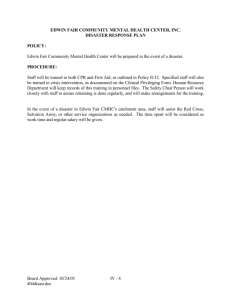guyana - DISASTER info DESASTRES

GUYANA
National Disaster Capacity Building Project
Total budget: USD 12,600,000
UNDP Sector: National Disaster Capacity Building
Starting Date: 1 st Qtr 2007
Duration: 18 months
Background:
Approximately ninety (90) percent of Guyana ’s population resides in localities below sea level.
The country’s vulnerability to flooding is exacerbated by its vast network of natural watercourses, linear development in close proximity to these, and development of communities around seaports and coastal areas. Comprehensive disaster risk reduction strategies have not been developed.
The political directorate, civil society and private sector interests have neither articulated nor demonstrated that disaster management is a priority strategic development issue. Hazard recognition, mitigation, preparedness and response strategies have not been adequately developed and the risk of inimical impacts on persons and property due to flooding are unacceptable.
In recognition of these, the government of Guyana is mobilizing to embark upon National Disaster
Capacity Building. Already, based on formative research previously undertaken by a consultant team, five (5) key areas have been identified that once addressed, will strengthen the country’s disaster management capacity.
1. Project Development Objective:
To improve Guyana’s disaster management capacity by: a) strengthening institutional capability in disaster management at the national level; b) building institutional capacity for disaster mitigation at the national level; c) promoting disaster awareness and "preventive thinking" through public sector education and awareness programs; d) building local capacity to manage emergencies, assess risk and identify mitigation measures; and e) implementing vulnerability reduction and mitigation measures at the local level.
2. Key performance indicators:
Assessing the achievement of the project's development objective will be accomplished by tracking outcome and impact indicators that measure: increased capacity of the National
System for Disaster Mitigation, Preparedness and Response, improved technical knowledge, increased local government capability for disaster management, and reduced vulnerability of the population in highly vulnerable localities. Outcome indicators include inter alia, a fully operational national coordinating entity, to be named the Civil Defense Commission (CDC) , which is to be provided with adequate human and physical resources, capital and operational funding, and clear operational and procedural standards. The performance of the CDC and
2 the National System, will be measured during the life of the project through the evaluation of selected disaster management activities (including emergency simulation exercises, management of the emergency operations center, organization of the local disaster management committees), the National System’s actual emergency responses, simulation exercises, and the work of the National System's intersectoral and territorial commissions.
Project impact will be assessed through evaluations to measure the success of the national disaster awareness campaign and the mainstreaming of disaster themes in formal education curricula on the one hand; and through impact evaluations of preventive planning exercises and mitigation measures carried out in selected localities. The latter will look at indicators such as the total number of people targeted in rural and urban areas, total square kilometers of hazardous areas protected from future development, total number of schools retrofitted, total cost of investment per capita, etc.
Key staff of the CDC are to be identified, hired and trained within the first six months of the project; new facilities for the CDC including the Emergency Operations Center; vulnerability studies and mitigation strategies developed for Georgetown, key watersheds and a review of building codes leading to development of a national disaster mitigation plan by end of project;
60 % of school teachers trained in disaster awareness by end of project; at least 80% of local disaster management committees organized by end of project; hazard and vulnerability assessments, hazard mapping, identification of mitigation measures and preventive planning activities undertaken in all administrative regions by end of project; and mitigation measures completed in at least 70% of eligible administrative regions by end of project.
Strategic Context
Sector issues to be addressed by the project and strategic choices:
The project will assist the Guyana’s government to address the five major sector issues outlined at 1 above. At the national level, it will strengthen disaster prevention, preparedness and response, through support to the National System and the CDC, which will include providing technical assistance, equipment and initial operating costs.
To address the need for a national mitigation strategy, the project will support the CDC through provision of an information management system and through financing of key studies to define both mitigation policies and future mitigation activities.
Regarding the need to bring disaster awareness into public practice and to civil society, the project will finance the development and implementation of curricula for the formal education system. It will also finance a disaster awareness campaign for the general public through the media.
At the local level, the project will support emergency preparedness by assuring the organization, training and equipping of emergency response committees in all regions. In addition, the project will provide mitigation help to twenty-five (25) Town & Village
Councils, identified as being the most vulnerable to natural disasters, by carrying out technically supported risk assessments and vulnerability analyses and subsequently developing "preventative" land use plans and specific disaster mitigation programs.
The project will also provide financing to implement a small number of high-impact, priority mitigation measures identified in the twenty-five (25) Town & Village Councils. In the process the project will leave a capacity in place for technical review of program components.
3
In developing this project proposal three (3) strategic choices were considered. Firstly, to identify and support a relatively short project as a first measure within the long term goal of making the National System operational. This would reflect a measured approach.
Secondly, the project to be designed to complement the work of donor agencies, based on careful review of obtainable technical and other resource assistance for disaster management.
Thirdly, comparative vulnerabilities of administrative regions within the national system
A mixed approach will be adopted.
Project Description Summary
1. Project components:
A. Strengthening of National System Capacity for Disaster Management
This component would be facilitated by CDC through its Planning Division. It would ensure the sustainable establishment of the National System while strengthening its capacity to respond to, prevent and prepare for natural disasters through the following subcomponents:
A.1. Institutional Strengthening of the CDC through:
(a) Organizational Development and the Establishment of Capabilities in Planning and
Project Management
(b) Improvement of Physical Plant and Equipment e.g. acquiring water tenders and construction of food storage bonds
A.2. Strengthening of the National System through:
(a) Development of National Emergency Plans, e.g. shelter management and evacuation plans
(b) Improving National Emergency Response Capability e.g. acquisition of all terrain vehicles and inflatable boats; and
(c) A National Program of Emergency Simulations.
B. Development of National Mitigation Program and Strategy
This component will be the responsibility of the CDC, which will work closely with technical agencies. The objective is to improve the capacity of key technical agencies to gather, analyze and share scientific knowledge and to develop studies leading to the development of mitigation policies and strategy. The following sub-components would be financed:
B.I Mitigation Information System through:
(a) consultancies to design and set up an information management system linking key technical agencies of the National System; and
(b) acquisition and installation of needed hardware and software, and training to staff from the participating agencies.
B.2 Development of a resettlement policy for application in cases of homes at risk from natural disasters.
4
B.3 Strategic Mitigation Studies to define a national mitigation program through consultancies to:
(a) Assess watershed vulnerability overall and to carry out a pilot mitigation plan in a priority watershed;
(b) Prepare a Flooding vulnerability assessment for Georgetown; and
(c) Review and update the national building codes.
B.4 Preparation of a long term National mitigation program and strategy based on findings of other studies.
B.5 Provision of Expert Technical Assistance in local vulnerability analyses and identification of mitigation measures in support of sub-component D.2.
C. Building Public Awareness of Disaster Prevention
This component is focused on making disaster prevention a part of daily life and culture and will be facilitated by the Public Relations Division of the CDC in collaboration with the Ministries of
Public Information and Education, and Ministry of Health. In addition to a Public Relations expert to manage the component, various activities under the following sub-components:
C.1 Mainstreaming Disaster Awareness into Formal Education: (In conjunction with the Ministry of
Education)
(a) consultancies to update methodological guides for teachers to design and produce instructive materials for application in formal school programs; and to evaluate the incorporation of disaster awareness into the formal education system; and
(b) Training for teachers in the use of the new methodological guides and teaching plans.
C.2 Public Awareness Program, covering
(a) Consultancies to design a public awareness campaign, including information on disaster management and the National System and to design graphic, radio and visual programs to promote disaster knowledge
(b) Production of multimedia materials and dissemination through the media.(Health
Education Campaigns)
C.3 Strengthening Disaster Knowledge in the Communications Media through:
(a) Training for journalists and communications employees; and
(b) Consultancies to review and propose reforms in the education curricula for communications professionals.
D. Strengthening Local Capacity for Disaster Risk Management
The Planning Division of the CDC will be responsible for the implementation of this component, in coordination with Town & Village Councils, and Civil Works, the sub-components listed below with the objective of reducing vulnerability at the Town & Village Council level:
D.1 Consolidation of Committees for Disaster Management: Responsibility for disaster response in Guyana rests with CDC. The objective of this subcomponent is to organize, equip and train committees for disaster emergency response throughout the country's administrative regions.
The Civil Defense Commission will work in the purchase of emergency response and disaster prevention equipment (first aid needs, search and rescue materials, communications equipment, etc). It will also carry out training of two kinds:
(a) organization of the committees, including distribution of equipment for emergency response; and
5
(b) Training in use of equipment and in emergency response including development of local emergency response plans, and local simulation exercises.
(c) Formulating Memoranda of Understanding with local agencies for disaster response
D.2 Promotion of "Preventive Planning." With the objectives of strengthening Councils planning and technical groups in disaster prevention, this component will introduce techniques of vulnerability assessments and mitigation planning to a pilot group of 25 Town & Village Council, identified as the most vulnerable to natural disasters. Financing under this sub-component will support consultancies for teams which combine technical expertise in disaster assessments with experience in participatory planning and community development to:
(a) carry out hazard analyses, vulnerability mapping, identification of mitigation measures and prioritization of these measures in each selected municipality; and
(b) prepare long-term land use plans which identify areas at risk and actions to avoid inappropriate land use in future developments.
E. Implementation of Local Vulnerability Reduction Measures
This component would be the responsibility of Town & Village Councils, but would be supervised by the CDC. Support to Town & Village Councils for project financial management will be provided through project financial administration. Town & Village Councils will develop annual operating plans in conjunction with their Administration regions:
E.I Selection of Sub-Projects and Preparation of Administration regions Investment Plan
E.2 Implementation and Evaluation of Mitigation Measures
F. Project Financial Management
A project financial administrative strategy will be developed as to govern procurement, contracting and acquisitions, flow of funds, disbursements, payments, internal and external auditing and financial reporting to IDA. Financial administration will be done by Financial Unit, which will report to the Planning Unit in the CDC, which is charged with project management. The project will finance their additional needs for staffing, office equipment, hardware and software, and training. Financing will cover costs of:
(a) consultancies to cover additional procurement and accounting needs for the Financial
Unit;
(b) acquisition of software, computers and office furnishings; and
(c) consultancies to cover additional procurement and accounting needs for the CDC
2. Key policy and institutional reforms supported by the project:
The principal institutional reform supported by the project concerns the establishment of the
National System for Disaster Prevention, Mitigation and Response, and of the CDC as its coordinating authority. The Executive Branch of National Government has taken responsibility for disaster management and made preparation and mitigation issues a matter of public sector mandate. Consequent institutional and policy reforms, as affecting Town & Village Council jurisdictions and procedures, public sector performance, incorporation of disaster awareness into on-going programs, and private sector involvement will also be promoted through an effectively established system for disaster prevention, mitigation and response.
6
3. Benefits and target population:
All populations at risk from natural disasters in addition to the national community will directly benefit from this project. Given the geo-spatial distribution of human settlements in Guyana, most groups living at risk occupy marginal urban settlements and rural communities and are poor. The selection process used to identify highly vulnerable Town & Village Council included a poverty analysis as well as hazard risk mapping.
4. Institutional and implementation arrangements:
The CDC will be responsible for overall project management and, ultimately, for its successful implementation. Within the Commission, project management will be the direct responsibility of its
Planning Unit. The Planning Unit of the CDC will also be responsible for the implementation.
The CDC is accountable to the Office of the President.
The remaining project components are each the responsibility of different Departments of the
CDC or agencies of the System, such as Coordination, Public Relations, etc. These departments and agencies together form the Project Committee for Project Implementation, which is headed by the Planning Unit of the CDC.
Project Rationale
1. Project alternatives considered and reasons for rejection
Longer Time Frame and Broader Project Scope
Role of the CDC
2. Major related projects financed by the Bank and/or other development agencies (completed, ongoing and planned).
3. Lessons learned and reflected in the project design
4. Indications of borrower commitment and ownership
Summary Project Analysis
1. Economic
The economic benefits of investments in disaster mitigation and prevention are perceived in reduced losses when catastrophic events occur.
2. Financial
The greatest portion of funds will be directed at measures which translate into avoided losses of lives and property during natural disasters.
3. Technical:
7
Specialized technical expertise will be required under the Strengthening Local Capacity for
Disaster Risk Management and Implementation of Local Vulnerability Reduction Measures to assist in vulnerability analysis and risk mapping at the local level and to assess the financial, environmental and structural feasibility of sub-projects proposed.
4. Institutional:
Executing agencies
Project management
Procurement procedures
Financial management
5. Environmental:
The majority of civil works will involve restoration and protection of the environment, retrofitting of existing infrastructure, and are not expected to have any negative environmental effects
6. Social:
1. Key social issue:
No major social issues are foreseen. Ongoing research suggests that disaster impacts may be felt differently by gender and by indigenous groups. Efforts will be made to ensure a group-sensitive approach to the participatory process.
2. Intersectoral collaboration / consultations with NGOs and other civil society organizations
Sustainability and Risks
1. Sustainability:
Sustainability of project objectives depend on two key variables; a. The successful mainstreaming of disaster awareness concerns into operations by other
Ministries and agencies b. The ability of the National System to operate during and beyond the change in political administrations.
2. Critical Risks
Personnel
Trained staff does not remain in the CDC, Public sector employees are not very interested in disaster issues, National disaster awareness campaign does not reach out to all vulnerable population, and Administrative Regions are not interested in vulnerability reduction activities
Funding
Government fails to contribute to operating costs of the CDC and National System, There is not adequate capacity in the CDC to coordinate tasks across various agencies and to supervise consultants, and Hiring of consultants and procurement of equipment is not carried out on a timely fashion.
3. Possible Controversial Aspects: None foreseeable
8








